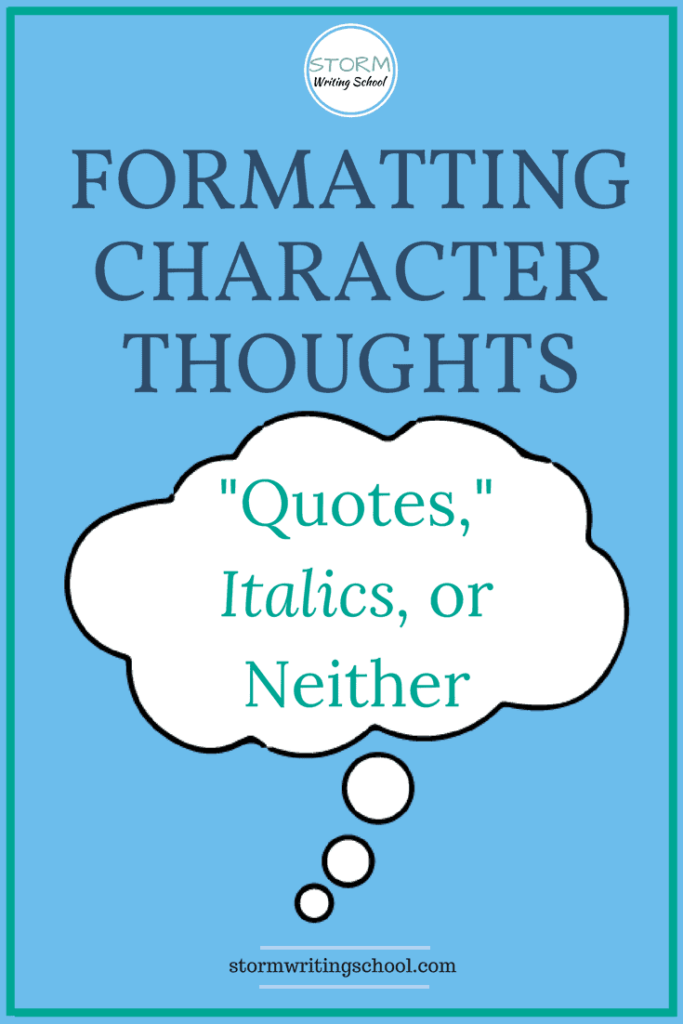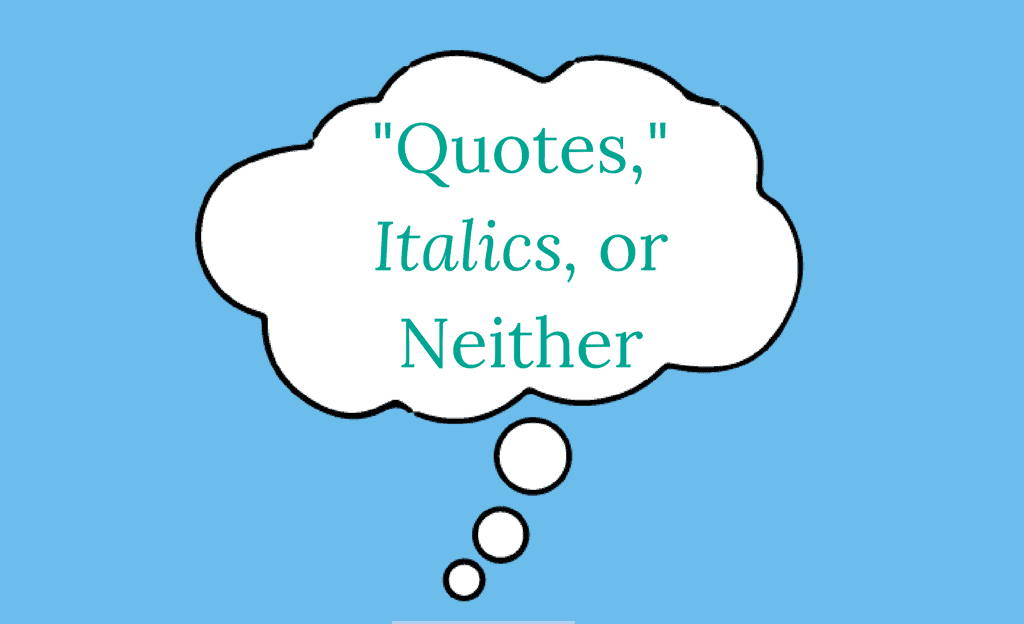It’s the rare book that doesn’t have character thoughts narrated. Indeed, one of the main differences between film and books is the fact that books render interiority in more detail and more frequently.
Yes, some books do more with interiority than others, but nearly all of them narrate thought. Should you do anything special to format character thoughts?
Some people advise using quotation marks; some advise italics.
I advise neither.

The Problem with Quotation Marks
You’re likely to create confusion. That’s the problem. Readers know that quotes are for speech. And so that’s what they’ll be expecting upon reading an internal monologue in quotation marks. It’s not until they get to the thought tag (he thought, she wondered, etc.) that they’ll be clued into the fact that the words they just read were not spoken out loud.
Take a look:
“Do you think she saw us?” Cody whispered.
“No,” Jenny said. “She’s too stupid.”
“That’s a gutsy thing to say,” Cody thought.
Pretty awkward, right?
What About Italics?
If you were to use italics instead of quotes in the snippet above, it would be clearer, I suppose. But is it really necessary?
Here’s the thing: the narrator can fluidly move in and out of a character’s thoughts. There’s a spectrum of distance between a narrator and character. At what point in that spectrum should italics be used? Take a look at the following passage, for instance:
Streater looked down at the old skates. The blue leather cracked and lined. The laces frayed. Damn. Nothing stayed the way it should. Not Elayne, not the house, nothing. He leaned down and pulled the laces to see if they had rotted. One snapped off right at the top eyelet.
Everything from “Damn” to “nothing” is direct character thought. But are the observations about the blue leather and laces not also thoughts from the character? They’re undeniably tinged with his perception.
See how messy this gets?
What about this next one?
This is really creepy, she thought, stumbling in the darkness through the brambles. There was an old barn here somewhere. She’d be okay if she could just find it. Suddenly the barn doors burst open and a tractor bore down on her. Oh, my God, I’m going to die.
Clearly, “This is really creepy” is a thought, made obvious by the thought tag (“she thought”). The final sentence is a thought, too, made obvious by the switch to first-person present tense. But what about that sentence “There was an old barn here somewhere”? That could certainly be a thought from the character. Does it harm the passage if we don’t put that sentence in italics? And “She’d be okay if she could just find it” is also character interiority. Do you need all thoughts in italics?
Neither Quotes nor Italics
Again, there’s a spectrum of character thought. The narrator can write from varying “psychic distances” from the character. Some sentences deliver a purely internal expression; others are tinged with perception; some are internal dialogue. The reader doesn’t need to have pointed out to him the ones that are closest to the character.
My solution: let the narrator narrate and don’t worry about demarcating character thought in any special way. Look up above at that passage about Streater. Did you have any trouble following it without italics?
Now, take a look at this passage:
Kirsch felt more bemused than intimidated as he studied the three aging men before him. So this is the Holy Trinity I requested. The Three Wise Men.
See how the author moves from third person to first person and changes from past to present tense (a technique I see a lot of)? Why do that? The passage could just as easily remain in third person and still accomplish everything it’s accomplishing.
Kirsch felt more bemused than intimidated as he studied the three aging men before him. So this was the Holy Trinity he requested. The Three Wise Men.
All I’m saying is there’s no need to shift verb tense and person. If you’re writing in third-person past tense, stay in third-person past tense and don’t give us a single sentence that is in first-person present tense.
Let the narrator—not the character—narrate. (If that distinction between character and narrator isn’t clear, read this article.)
Avoid Awkwardness
There are, however, some cases where it will feel awkward to maintain the narrative person and tense. Let’s return to our woman coming upon the diabolical tractor, specifically this thought: “Oh, my God, I’m going to die.” That’s a sentence that changes to first-person present tense. And the author of the original passage cast it in italics (which I took out so as not to bias your judgments of whether it needed italics).
If we were to maintain third-person past, the sentence would read, “Oh, her God, she was going to die,” which is obviously ridiculous. But even if we cut “her,” the sentence still seems awkward to me: “Oh God, she was going to die.”
So in this case, I’d recommend using another thought tag:
Oh my God, she thought, I’m going to die.
There are simply going to be some times when including a thought tag is the best thing to do.
But be judicious.
Narration is the Key
Look back at the full passage: is it necessary to have a thought tag for the first sentence, “This is really creepy, she thought”? Or can we revise the passage to evoke creepiness and to have her thought be more specific? And in doing so, can we put ourselves in her situation a bit more and come up with a scene that carries more tension?
Nora stumbled in the darkness through the brambles, holding her hands in front of her to guard from a lash to the face. Something tickled her arm. Was it a spider? She slapped herself just as she stepped free from the undergrowth. Off to her right, she heard someone laughing, deep and low. She froze and listened, holding her breath. There it was again. But it wasn’t a laugh. It was a horse! There was an old barn here somewhere. She’d be okay if she could just find it. But then another noise grumbled through the dark, and she thought she felt the earth trembling beneath her feet. Had Chelsea been right? Was the world in its final days? Was this the rapture she and Greg had talked about? Nora crossed herself like she’d seen Chelsea do before every meal. Suddenly the barn doors burst open and a tractor bore down on her. Oh, my God, she thought, I’m going to die.
(I’d probably even go into more glorious detail about that menacing tractor, but you get the idea.)
But hey, I’m just arguing my case. There are no rules. You can use italics in all sorts of inventive ways, and as long as your reader isn’t confused by how you’re rendering the story, you’ll be fine. You can certainly find successful published examples of all sides of the argument. I just think that you almost always make your narration stronger when you let go of the italics crutch. (When I was crafting the rewritten version of the diabolical tractor above, I found myself being pushed toward better scene creation altogether.)
In essence, signaling to your reader that your character is thinking is not a matter of formatting your words in any particular way; it’s just a matter of fluid narration.
Character interiority is one of my recurring subjects of discussion. Check out these other articles:
- 10 Lessons from “Cat Person” on Character Interiority
- Juggle External Action and Interiority
- Author, Narrator, Character
- Writing Emotion
Sign up for my newsletter to get biweekly notifications of new articles like this and some other helpful links.
SaveSave
SaveSave
SaveSave








8 Responses
Oh, and just in the interest of sourcing things: the Streater passage is from Jerome Stern’s Making Shapely Fiction as an example for rooting character interiority in something external. The tractor passage is from an article arguing for italics. It’s written by Maryann Miller at her blog The Blood-Red Pencil. The Kirsch passage is from Dan Brown’s novel Origins.
Here’s the link to the Maryann Miller post (it’s worth reading through the comments): http://bloodredpencil.blogspot.com/2009/02/ask-editor-internal-monologue.html
The formatting contradicted and confused the point of this post. As all the excerpts *are italicized* it’s hard to interpret what you mean about when and when not to use italics!
Ah, sorry. That was a default of the WordPress style I changed to after originally posting this. I think I just fixed it. Thanks for pointing it out.
When writing in deep POV, I find italicizing thoughts works well even with the tense change. I’m not keen on dialogue tags, and I really don’t like thought tags.
I’m enjoying your blog very much and have recommended it to my friends. Cheers.
Thanks, Shayne!
Your answers in the below comments make me confident you are smart and know what you’re doing. Thank you in advance for your time.
I’m a ridiculously new author, not sure if I can even call me that cuz I have no idea what I am doing but I told this story to my hubby and he said I have to write this s@#! is how he put it. I have trepidation with this fantasy, but could actually be happening, novel in my head that I am bumbling around trying to get this out of my head so I can sleep at night again! I’ve read through the history in this forum and I’ve tried to find any way to answer my question without bugging you, Sir. I’ve also searched tirelessly online and have read so very many exhaustingly long articles about when to use when not to use, but no examples of how I’m writing this. I’ve been ask for money when I try and do a chat session with websites that say they’ll answer a quick question they don’t without money. Please help… I’m deep in my book, and in my research everyone says italics are bad….
My story is told only through speech, thought, and many points of view. How can I get around italics?
I can’t THANK YOU enough for your help and if anything comes of this book you’ll be credited I PROMISE!! Thank You so much for your time and response!!
You may not have to get around italics. I mean, you can certainly find published books with italics for thoughts. But I contend that italics are often inconsistently applied and often unnecessary. Even if you’re encountering many sites that advise against italics, that doesn’t mean you have to listen. Writing is a case-by-case basis. Very few general rules apply to everything. That said, I think you can attempt free indirect style if you want to eliminate italics. I have a video explaining what free indirect style is. See if that helps. Otherwise, if you’re going with many points of view, it may actually be best to stick with thought tags in many cases (she thought, he wondered, etc.).